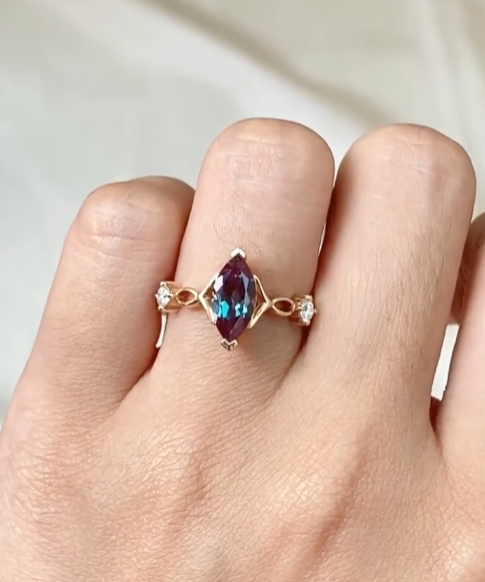Why Alexandrite Rings Change Color: Nature’s Rarest Phenomenon
Some jewelry dazzles with brilliance, but Alexandrite rings fascinate for a different reason—they seem to play tricks with light itself. One moment they gleam with a cool green glow, the next they shimmer in shades of red. It feels almost magical, yet behind this rare phenomenon lies a story where nature’s chemistry and light intertwine in perfect harmony.
The Discovery of Alexandrite and Its Rarity
Alexandrite was first discovered in the Ural Mountains of Russia in the 1830s and was named after Tsar Alexander II. Its striking ability to change color under different lighting conditions immediately set it apart from other gemstones. Natural Alexandrite is extremely rare, with high-quality stones found in very limited quantities, which makes it highly prized among collectors and jewelry enthusiasts. This rarity, combined with its unique optical properties, has cemented Alexandrite’s reputation as one of the most extraordinary and sought-after gemstones in the world.
Understanding the Gem
Alexandrite is a variety of the mineral chrysoberyl, distinguished by the presence of chromium, which gives it the remarkable color-changing effect. In daylight or fluorescent light, Alexandrite often appears green to bluish-green, while under incandescent or candlelight, it shifts to red, purplish-red, or even pinkish hues. The intensity of this color change varies depending on the quality of the stone, its size, and the concentration of chromium. Beyond its visual appeal, Alexandrite is a durable gemstone, ranking 8.5 on the Mohs hardness scale, making it suitable for daily wear in rings, earrings, and other jewelry pieces.

The Science Behind the Color Change
Alexandrite’s legendary color change is due to a phenomenon called the alexandrite effect, caused by the presence of chromium ions in its crystal structure. These ions absorb certain wavelengths of light differently depending on the type of lighting. In daylight or fluorescent light, which is rich in blue-green wavelengths, Alexandrite reflects green tones. Under incandescent light, which contains more red wavelengths, the stone appears red or purplish. This rare optical behavior, known as pleochroism, is what makes Alexandrite truly unique among gemstones. Each stone’s color shift is slightly different, giving every Alexandrite gem a distinct personality and charm that cannot be replicated.
How Light Influences the Gem’s Appearance
The way Alexandrite interacts with light is central to its captivating charm. Daylight or fluorescent light, which contains more blue-green wavelengths, emphasizes the stone’s green tones, while incandescent or candlelight, rich in red wavelengths, brings out red or purplish hues. The angle and intensity of light can also subtly alter the perceived color, making the gem appear different throughout the day. This dynamic interplay between light and crystal structure is what gives Alexandrite its magical reputation, allowing wearers to enjoy a gemstone that seems almost alive, changing with every lighting condition.
Natural vs. Lab-Grown Alexandrite: Do They Change Color the Same Way?
Imagine holding an Alexandrite under the bright midday sun—it glows green, almost like a jewel captured from a forest. Bring it into warm indoor lighting, and it turns a rich red, as if the gem itself is responding to its surroundings. Both natural and lab-grown Alexandrite perform this magic, with lab-grown stones carefully engineered to mimic the exact color-shifting properties of their natural cousins. While natural Alexandrite remains rare and coveted, lab-grown options let more people enjoy this enchanting effect. Lab-grown alexandrite rings from Amandafinejewelry, for example, offer the same captivating experience with ethical sourcing and affordability, making this rare phenomenon accessible without compromise.
Factors Affecting Color Intensity in Alexandrite Rings
Chromium Content
The amount of chromium in an Alexandrite crystal is the primary factor that determines the intensity of its color change. Higher chromium concentrations typically produce more vivid shifts between green and red, while lower levels may result in a subtler effect.
Lighting Conditions
Different light sources dramatically influence how Alexandrite appears. Fluorescent or daylight emphasizes green tones, whereas incandescent or candlelight highlights red hues. The intensity and angle of light can also subtly modify the stone’s appearance.
Stone Size and Cut
Larger stones and certain cuts, such as oval or cushion, can enhance the color-changing effect by allowing more light to interact with the crystal structure. Poorly cut stones may appear duller and reduce the visual impact of the color shift.
Clarity and Inclusions
While minor inclusions are natural and do not significantly affect the gem’s color, heavy or dark inclusions can interfere with light transmission and diminish the dramatic color change. High-clarity stones tend to show more pronounced color shifts.
How Alexandrite Reflects Transformation and Balance
Alexandrite’s color-changing nature has long been associated with transformation and balance. Just as the gem shifts between green and red, it symbolizes the ability to adapt gracefully to life’s changes while maintaining inner harmony. Many wearers see Alexandrite as a reminder of personal growth and resilience, making it not only a stunning piece of jewelry but also a meaningful talisman. Its dual nature encourages mindfulness, balance, and the appreciation of life’s subtle shifts, which is why Alexandrite has captivated both jewelers and collectors for nearly two centuries.
Conclusion
Alexandrite remains one of nature’s most fascinating gemstones, celebrated for its rare color-changing ability, durability, and symbolic meaning. From its discovery in the Ural Mountains to its modern use in rings and fine jewelry, it continues to captivate collectors and enthusiasts alike. Understanding its mineral composition, the science behind its color shift, and the factors that influence its appearance allows wearers to truly appreciate each stone’s uniqueness. For those seeking a sustainable and accessible option, lab-grown Alexandrite rings offer the same mesmerizing transformation, making it possible to enjoy this extraordinary gem in a meaningful and stylish way.
FAQs About The Color-changing Alexandrite Rings
What causes Alexandrite to change color?
Alexandrite changes color because of chromium elements in its crystal structure, which absorb light differently under various lighting conditions.
Why does Alexandrite look green in daylight but red under warm light?
This effect happens because daylight has more blue and green wavelengths, while incandescent or candlelight has more red tones, causing the gemstone to shift hues.
Do all Alexandrite rings show a strong color change?
Not all Alexandrite stones display the same intensity of color change. The strength depends on quality, cut, and light exposure.
Does lab-grown Alexandrite change color like natural Alexandrite?
Yes, high-quality lab-grown Alexandrite has the same chemical composition and structure, so it shows the same color-changing effect.
What lighting is best to see Alexandrite’s color change?
To see its full color range, compare the gem under daylight (or fluorescent light) and incandescent light. The contrast will reveal the transformation best.
Why is Alexandrite called ‘Nature’s rarest phenomenon’?
Because the combination of geological and chemical conditions required for its formation is extremely rare, making color-changing Alexandrite one of the rarest gemstones on Earth.
Does the color change fade over time?
No, Alexandrite’s color-changing property is stable and permanent if the gemstone is properly cared for and protected from damage or harsh chemicals.
Is the color change more visible in larger stones?
Generally, yes. Larger Alexandrite stones with high clarity and good cuts tend to show more distinct color transitions.
What emotions or meanings are associated with Alexandrite’s color change?
It symbolizes transformation, balance, and adaptability, reflecting how light and perspective can reveal different sides of beauty.



